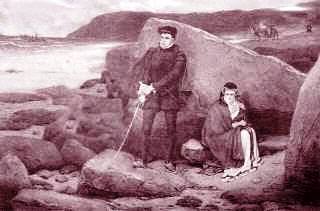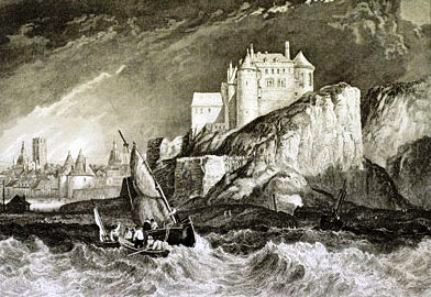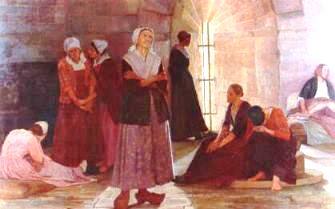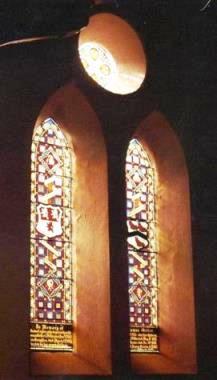jean malandain + marthe baudoin
Jean and his wife, Marthe Baudoin, arrived in England as refugees in 1688. They were listed as ‘confesseurs’, those who suffered or were tortured because of their Protestant faith, and were among a group of deportees ordered out of France by Louis XIV:
Noms des Confesseurs qui par les ordres du Roi Louis XIV furent amenez de diverses prisons au Chateau de Dieppe en Mars et Avril, 1688 et embarquez par le meme ordre le 27 Avril, pour etre transportez en Angleterre - Goderville: Jean Malandain, Marthe Baudouin sa femme.

Jean was born in Normandy in 1648, the son of Pierre Malandain and Anne Fichet. Pierre and Anne were married in Lintot, Normandy on 18 June 1634 and Pierre’s father was listed as Jean Malandain but his mother’s name was not recorded in the marriage entry. Anne’s parents are not listed but her birthplace was recorded as Bolbec, a village 7 km to the west.
Marthe Baudoin was born in Sausseuzemare, Normandy in 1658, the daughter of Jean Baudoin and Judith Lemarie.
Jean and Marthe were married on 13 February 1678 in Criquetot L’Esneval, a small village between Fecamp and Bolbec and in subsequent records, Jean’s occupation was listed as ploughman and farmer. Their son, Pierre, was born in France prior to 1688 and although no birth record has been found, all records relating to him note that he was born in Normandy.
Jean and Marthe were arrested by the French authorities in Doullens, Picardy on 14 January 1686. They were apprehended over 100 kms north of their home in Normandy so it is possible that they were attempting to flee France, either through the port at Calais or over the border and into Belgium. The arrest record also notes that their two young sons were with them when they were arrested and although their names and ages were not listed, it does note that the boys were not detained along with their parents ‘due to their young age.’ Many Huguenot children were forcibly taken from their parents and fostered with Catholic families but there is no mention of what happened to the two boys following their parents’ arrest.

On 24 January, Jean and Marthe were transferred from Doullens to the chateau at Dieppe and while Marthe remained in prison in Dieppe, Jean was sent on to Aumale, 75 kms northeast of Rouens. Another Huguenot, Jean Perigal, was also imprisoned at Aumale and wrote an account of his detention:
‘In the prison at Dieppe, I met other prisoners who had been arrested for their religion like me, but within a few days we were told it was the will of the King for us to be sent to the dungeons of the chateau of Aumale. We were taken there in a cart of men, women and girls; some of whom were put in the rooms of the chateau and others in the cellars. The cellars were made of brick, all equally deprived of light, where we were fed only with bread and water. One of our brothers, named Jean Malandain, a strong and robust man, was led to an underground cellar which was more than one hundred steps underground.’
Jean was held alone in the underground cell for five weeks before being moved into a cell with other prisoners, including Perigal:
‘When he heard us, he was very happy. Our presence was a reinforcement to his body and spirit, and he greatly rejoiced in our company. We could speak easily from one dungeon to the other, as three of them were very close to each other, only having a door separating us. When we made our devotions, one among the three of us would say a prayer that the others could hear; this was for us a great consolation. That we did not expect to be long in these dungeons meant little - we did not think of leaving, although we could have done so extremely easily by forsaking our faith.’
Jean Malandain was incarcerated in the prison at Aumale for over two years until Louis XIV decided to clear his overflowing prisons in Normandy of the remaining Protestants who had held to their beliefs and refused to renounce their faith. In February of that year, he wrote from the palace of Versailles to Monsieur Freydeau de Brous, his superintendent in Rouen:
‘Having estimates in connection with making leave my kingdom the small number of my subjects who have persisted to now in their obstinacy not to abjure the Protestant religion, I write you this letter to tell you to withdraw from the chateaux and prisons of your Department, those Protestants that they contain, to take them to Dieppe, and there embark them in a vessel which shall carry out them out of my state.’

On 27 March 1688, Jean Malandain was brought back to the chateau of Dieppe to join his wife, Marthe Baudouin, who had been held there ever since their arrest two years earlier and they were deported to England one month later on 27 April 1688. On their deportation order, Jean was listed as a labourer, aged 43, and his wife, aged 30, was listed as being from St Anthoine de la Foret but no children were recorded. They embarked for England in a 40-ton sailing ship, together with the other 92 prisoners expelled from the jails of Dieppe, Rouen, Le Havre, Caen and the surrounding towns. After a calm 20-hour voyage, they landed at Dover, and travelled across Kent, via Canterbury and Rochester, to Gravesend and from there, they sailed up the river Thames where they finally arrived in London on 1 May 1688.
Jean, Marthe and their young son joined the Huguenot community in London and remained there for the next three years. Pierre first appears in published records when he married Susanne Mole in London on 6 July 1709. The marriage entry confirms that he was a native of Normandy and assuming an age at marriage of 20 — 25yrs, his estimated birth date would be between 1684 and 1689. Therefore, it is possible that he was one of the children arrested with his parents but what happened to Pierre and his brother following the arrest is not known.
Their second son, Jean, was born in London about 1691. But by 1694, the family had left London and moved to the Huguenot community of Portarlington in Ireland which consisted primarily of retired military personnel:
‘The first wave of French immigrants arrived in 1692, many of whom were pensioned-off soldiers and their families who had served in the armies of William of Orange in Ireland. Most came from the officer class, which, at that time, was made up of sons of noble families. There were six ensigns, one cornet, 16 lieutenants, 12 captains and one lieutenant-colonel. However, the nobles of that era could hardly have been expected to fend for themselves, and a second group of ‘labourers’ 13 families in all, arrived from the Swiss cantons where they had taken refuge, and gave the colony a more balanced character.’

‘Let our help be in the name of God who has made the sky and the earth, Amen.’ With these words, Pasteur Jacques Gillet completed the heading for the register of baptisms, marriages and burials for the French Church in Portarlington in 1694.
Their third son, Daniel, was born in Portarlington on 26 July 1696 and his baptism was recorded in the Registers of the French Church:
Portarlington Du Mercredy 29th Juillet, 1696, Baptesme: Daniel Malandin – Le dimanche 26me dudit mois sur lat minuit est ne un fils au Sieur Jean Mallandin et Marthe Baudouin, sa femme, qui a ete ce jourdhuy presente au Baptesme par Messire Daniel Le Grand, Chevalier Seigneur de Petit Bosc, lieutenant colonel parain, et par Mademoiselle Angelique Daunis, (fille de Monsieur Daunis, capitaine) marraine et nom luy a ete impose Daniel par nous.
However, no further records relating to Daniel, either in Ireland or England, have been found so it is assumed he died in infancy.
In his son’s baptismal record, Jean was described as a Sieur - a term used to describe ‘a non-noble person who holds a ‘fief’ or property under the lord of the manor to whom he would pay his manoral dues, such as a certain number of pullets, eggs, heriots, etc. In the case of refugee families, the territorial title was used by the refugee, and also by his son, because there was always hope, so often expressed in wills, of the return to France.’ This description is consistent with associated records that list Jean as a ploughman or farmer.
There is no record of what led them to Portarlington but by 1699, they had returned to London and settled in Spitalfields. Based on the testimony provided by the Huguenot churches in Wandsworth and Ireland, Jean was admitted to the French Church on Threadneedle Street on 23 April 1699. Jean and Marthe also appear as godparents in numerous baptismal records in the registers of Threadneedle Street from 1701 to 1707 and Marthe appears in baptisms as late as 1712.
In 1685, King Charles II began a sponsorship scheme called the Royal Bounty to provide funds to poor French refugees and the scheme continued until 1724. The disbursement records show that Jean received funds totalling £7 in 1705 and it also confirms that he was both a ‘confesseur’ and a farmer. At the time, he was 63 years old, with a wife aged 51 years, and resided in Spitalfields. Jean and Marthe received an additional £8 in 1707. The last known record relating to Jean appears in the Letters of Denization and Acts of Naturalization for Aliens in England and Ireland 1701-1800 which confirms that Jean was granted the rights of citizenship in 1710 after swearing an oath to Queen Anne. Shortly after receiving citizenship, Jean's youngest son, Jean, married Marie Madelaine Halavant on 4 March 1710 at St Dunstan’s church in Stepney.
Marthe Baudoin died in Bethnal Green and was buried in the church yard at St Dunstan, Stepney on 9 October 1735. One month before her death, Marthe signed her last will and testament and named Samuel de Goullaine as her executor. She left legacies of one shilling each to three grandsons, Jean and Etienne (the sons of Jean and Marie Halavant) and Jean (the only surviving son from Pierre’s second marriage to Marianne Hardy). She also left her bed and ‘all that goes with it’ as well as her ‘one trunk and all that is in it’ to her 18 year old grandson David while the remainder of her estate was left to her granddaughter Susanna Le Doux. There were no legacies left to her sons, Pierre and Jean.
de Goullaine
The de Goullaine family had several connections with the Mallandain family. On 8 February 1708, Gabriel de Goullaine married Anne Mallandain at the church of Saint Jean in Spitalfields. Anne was from the Pierre branch of the family - the daughter of Pierre and Anne Despommare - and in 1711, Gabriel was also a witness to her sister Marie's marriage to Jacques Aleume. Lastly, Gabriel acted as godfather to Pierre and Marianne Hardy’s son, Gabriel, in 1726. Samuel de Goullaine was the only child of Gabriel and his wife Anne.
Jean and Marthe had sixteen grandchildren but sadly eight died in infancy including six who died in their first year. Marthe left legacies to five of the remaining eight grandchildren which confirms that they were still living in 1735. Questions still remain over the three not mentioned in her will — Pierre’s daughter Marthe and Jean’s children, Susanne and Jonas. It is possible they too died in infancy but no confirmation of their deaths has been found.
Marthe was listed as a widow in both her will and burial record but no corresponding death or burial has been located for Jean. He last appears in the records in 1710 which places his death somewhere between 1710 and 1735.